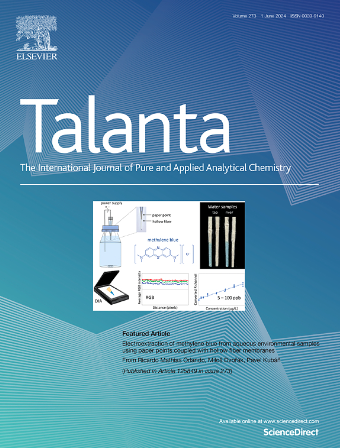Size-selected DNA hydrogels-based sensor with efficient intracellular delivery for imaging mRNA
IF 6.1
1区 化学
Q1 CHEMISTRY, ANALYTICAL
引用次数: 0
Abstract
Efficient delivery of DNA-based single-component hydrogels (DNA hydrogels) into cell is current challenge for its application in cell imaging. Since the size of nanomaterials affects its intracellular delivery, to identify an optimal size of DNA hydrogels, we designed a series of DNA sequences to construct three four-armed DNA structural unit including unit15, unit12 and unit9 in which the diameter of the structural unit of unit15, unit12 and unit9 were respectively estimated to be 10.2, 8.2 and 6.1 nm. These three four-armed DNA structural unit was assembled into three size-controlled DNA hydrogels (named DNA hydrogels15, DNA hydrogels12 and DNA hydrogels9, respectively) by DNA linker. These three DNA hydrogels could split by target c-myc mRNA and were tested in buffer. The response times of DNA hydrogels15, DNA hydrogels12 and DNA hydrogels9 to c-myc mRNA were 40 min, 30mins and 20 min, respectively, and their limits of detection were calculated to be 48.5 pM, 67.6 pM and 90.0 pM, respectively. Fluorescence imaging using these three DNA hydrogels indicated that DNA hydrogels12 internalized by the cells taken up ∼2 times higher than that of DNA hydrogels15. Taking the vitro detection and efficient delivery together, DNA hydrogels12 could be the optimal size, which provide an interesting insight into the DNA hydrogels-based biosensor.

基于尺寸选择的DNA水凝胶传感器,具有高效的细胞内递送,用于成像mRNA
基于DNA的单组分水凝胶(DNA水凝胶)在细胞成像中的应用是目前面临的挑战。由于纳米材料的大小影响其在细胞内的传递,为了确定最佳的DNA水凝胶大小,我们设计了一系列DNA序列,构建了三个四臂DNA结构单元,包括unit15、unit12和unit9,其中unit15、unit12和unit9的结构单元直径分别为10.2、8.2和6.1 nm。这三个四臂DNA结构单元通过DNA连接体组装成三种大小可控的DNA水凝胶(分别命名为DNA水凝胶15、DNA水凝胶12和DNA水凝胶9)。这三种DNA水凝胶均可被靶c-myc mRNA分裂,并在缓冲液中进行检测。DNA水凝胶15、DNA水凝胶12和DNA水凝胶9对c-myc mRNA的反应时间分别为40 min、30min和20 min,计算出其检出限分别为48.5 pM、67.6 pM和90.0 pM。使用这三种DNA水凝胶进行荧光成像表明,细胞吸收的DNA水凝胶12比DNA水凝胶高2倍。将体外检测和高效递送结合起来,DNA水凝胶可能是最佳尺寸,这为基于DNA水凝胶的生物传感器提供了一个有趣的见解。
本文章由计算机程序翻译,如有差异,请以英文原文为准。
求助全文
约1分钟内获得全文
求助全文
来源期刊

Talanta
化学-分析化学
CiteScore
12.30
自引率
4.90%
发文量
861
审稿时长
29 days
期刊介绍:
Talanta provides a forum for the publication of original research papers, short communications, and critical reviews in all branches of pure and applied analytical chemistry. Papers are evaluated based on established guidelines, including the fundamental nature of the study, scientific novelty, substantial improvement or advantage over existing technology or methods, and demonstrated analytical applicability. Original research papers on fundamental studies, and on novel sensor and instrumentation developments, are encouraged. Novel or improved applications in areas such as clinical and biological chemistry, environmental analysis, geochemistry, materials science and engineering, and analytical platforms for omics development are welcome.
Analytical performance of methods should be determined, including interference and matrix effects, and methods should be validated by comparison with a standard method, or analysis of a certified reference material. Simple spiking recoveries may not be sufficient. The developed method should especially comprise information on selectivity, sensitivity, detection limits, accuracy, and reliability. However, applying official validation or robustness studies to a routine method or technique does not necessarily constitute novelty. Proper statistical treatment of the data should be provided. Relevant literature should be cited, including related publications by the authors, and authors should discuss how their proposed methodology compares with previously reported methods.
 求助内容:
求助内容: 应助结果提醒方式:
应助结果提醒方式:


